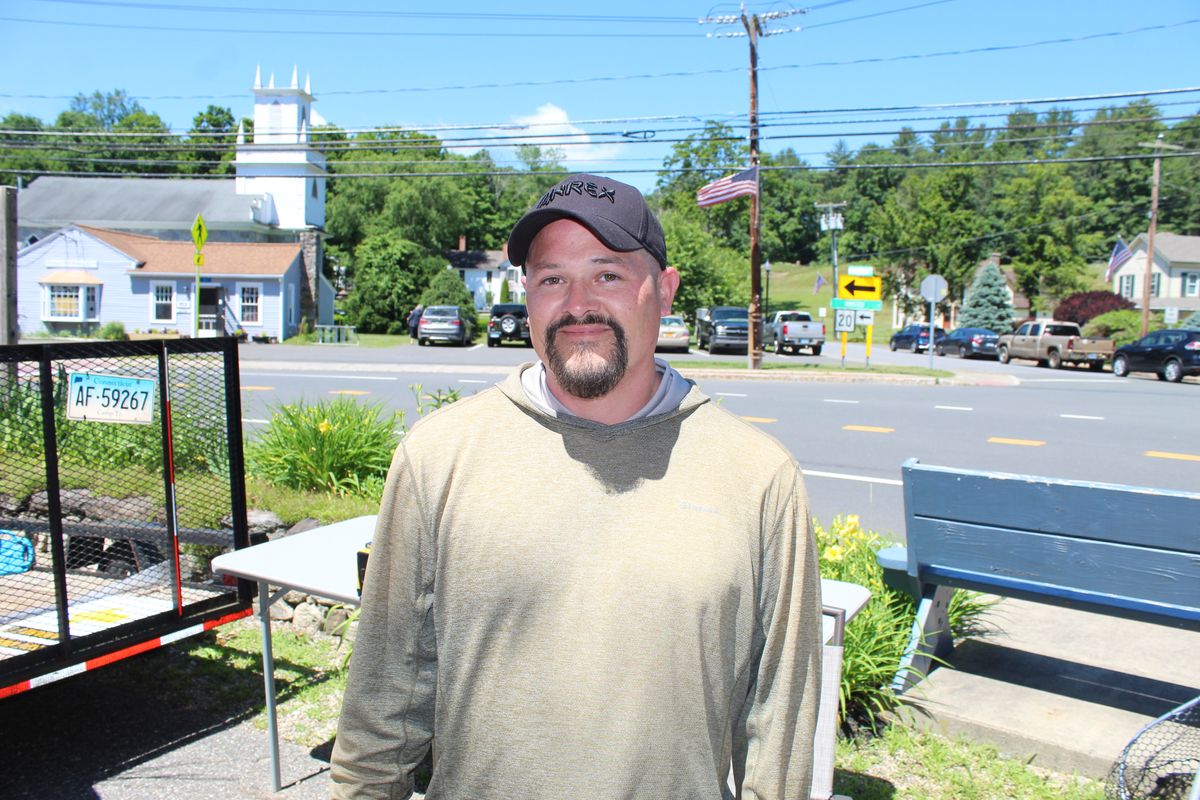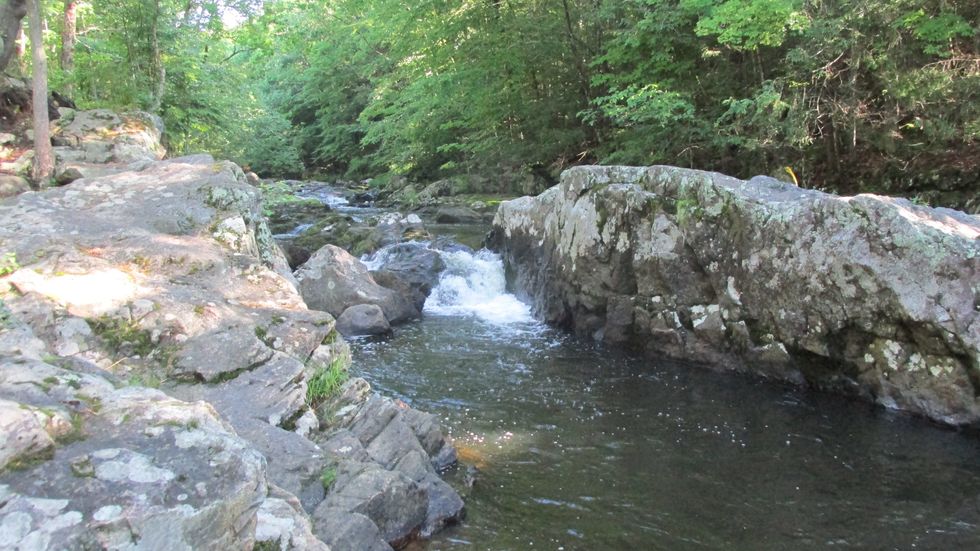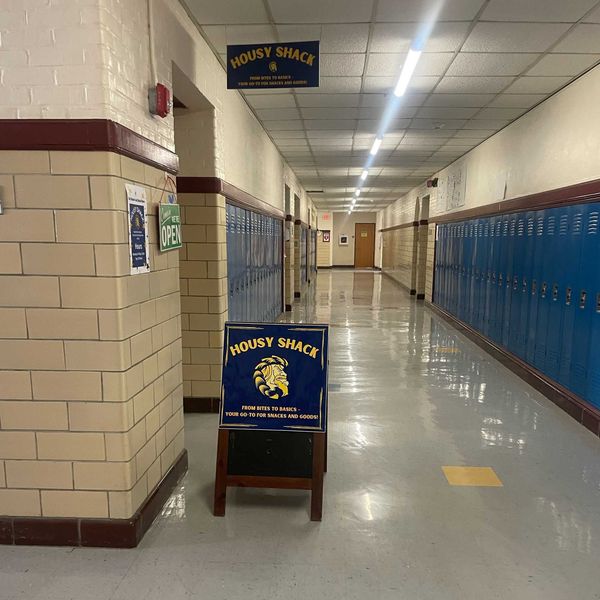Research and Development continues

Mike Barker provided a couple of well-crafted crawfish imitations.
Patrick L. Sullivan

Mike Barker provided a couple of well-crafted crawfish imitations.
Saturday, June 15 was clear and blessedly cool, ahead of what the weather ninnies assured me is a massive unprecedented disastrous heat wave.
I had one main item on the agenda, the angler’s flea market in Riverton.
So I figured I would prowl Sandy Brook beforehand.
Sandy Brook in Colebrook is a secondary tributary of the West Branch of the Farmington. I know this because I am a highly trained observer, and because I found a United States Geological Survey map that says so.
I am happy to report that getting the map from the USGS website was simple. Go to usgs.gov and look for The National Map, which is exactly what it says it is.
The state stocks Sandy Brook, twice this spring. With what exactly I do not know.
I’ve fooled around in this stream a couple times before, with minimal results. But I always came at it moving upstream, off Route 8.
This time, coming downstream on Sandy Brook Road (another triumph of clarity in labeling) I saw the stream and a couple of pull-offs with DEEP signs regarding creel limits and so on.
So I pulled off and suited up.
Water temperature at 8 a.m. was 63 in a shallow spot next to the bank. Not ideal, perhaps, but not terrible either.
I noticed the stream running roughly north-south, was almost completely shaded over at that hour, with the sun just starting to get through the canopy from the east.
This is good. Streams that have an east-west flow get the full brunt of the sun during the course of the day. In the summer, this means warmer water.
The first thing I noticed was this bucolic, babbling brook is misnamed. It should be called “Super Slippery Brook.” It’s a lot of rock shelf and getting around is like the proverbial tap-dancing on ball bearings dipped in motor oil. Some actual sand would have been nice.
Next time I will wear felt soled boots with studs.

I deployed an eight-foot nine-inch four weight rod. There was plenty of room for casting and the four weight allowed for turning over a dry-dropper rig while not making a huge splash.
The rig was a Chubby Chernobyl on top and a size 16 Zug Bug, tied on a jig hook and with a heavy tungsten beadhead, on what started as two feet of 4X fluoro tippet tied to the hook of the Chubby with an improved clinch knot. (And don’t ask what an unimproved clinch knot is because I have no idea.)
This produced an immediate hangup and I lost the Zug. So I shortened the dropper to about 14 inches and put on another Zug.
This produced two immediate hookups of brook trout in the eight-to-10-inch range.
So far, so good.
I clambered downstream, because it looked slightly less slippery than upstream.
It wasn’t.
I found one cleft running into a deep, wide slot that just had to have fish in it. I worked it hard for 30 minutes, abandoning the dry-dropper and chucking the heavy artillery into the depths: Big Bread and Butter nymph, a Walt’s Worm, which has more lead than a .22 short, and Joe’s Weenie.
Bupkis. Infuriating.
Then I went back to the Chubby-Zug Bug rig and proceeded to catch a dozen more fish, including some browns and one lone rainbow.
I have no idea of the proportion of wild to stocked here. I can’t believe the state stocks eight-inch brookies, but maybe there’s some deep fish reason I don’t comprehend.
Around 11 a.m. I packed it in and went down to the flea market, which was in the little public space across the street from the post office.
A modest number of vendors were there, including Harold MacMillan who still runs Housatonic River Outfitters in Cornwall, albeit without the brick-and-mortar shop.
We exchanged fishing gossip, and he sold me a grab bag of bass poppers for an eminently reasonable 10 bucks.
Most of the vendors were selling conventional gear, which doesn’t interest me, but I did spot Mike Barker of Ansonia.
Barker is a garage door installer in real life, and ties flies as a side gig. He said it “calms the nerves” after a busy week driving all over the state installing garage doors.
He’s been tying and selling for about three years.
He had a couple of poppers the approximate size of Oklahoma, which he said were for getting the attention of big fish. Like the star of “Jaws.”
I picked up a couple of beautifully crafted crawfish imitations. I generally make do with a Wooly Bugger for this, but I like to encourage the up-and-comers.
So the Research & Development ratio was nice and balanced. I established that Sandy Brook is not very sandy but has a lot of hungry fish in it, and it probably stays cool enough to be plausible most of the time.
I found a cost-effective way to replenish the bass bug box.
And I contributed in a small way to a young fly tier’s craft.
The Community Closet at HVRHS is open for students to take clothes for any reason during the school day.
What started with one unexpected donation of clothes has grown into a quietly impactful resource for all students at HVRHS: the Community Closet. Now located in a spacious area above the cafeteria, the closet offers free clothing to any student for any reason.
The idea began a few years ago when a community member reached out to the former superintendent wondering if anyone at the school could benefit from used clothing that would otherwise go to waste. The superintendent then got in contact with Rachel Novak, the school social worker. “Once I had all those bags of clothes in my room, I was like, ‘I should put this in a space,’” Novak said. Her simple idea eventually became a full-sized closet accessible to all students.
From the beginning, Novak envisioned the closet as an inclusive space. “It’s open to anybody, it’s not just based on economic needs,” she said. Sustainability also plays a role. “Thinking about the environment, some students like to thrift and just get clothes that way,” Novak said.
After the initial donation, contributions continued to grow. “I reached out to our staff members and faculty,” Novak said. The most consistent donations come from the faculty at HVRHS and a few community members who learned about the closet. Finding teenage-appropriate clothes has been a challenge. “I get a lot of donations that are nice, but I don’t think teenagers would want to wear them,” Novak said.
Another ongoing obstacle has been awareness. Many students don’t know the closet exists at all. “That’s been the hard part,” Novak said. “Getting it out to the wider community of the school.” Novak is looking for students and staff to spread the word. “It helps because our school nurse knows and other faculty members,” she said. “When they know a student needs something, they just bring them up.”
Looking ahead, she hopes to promote the space more actively. “When we come back from this break, I do plan to … get fliers and all that up and going,” Novak said. There may even be an upcoming expansion — she has discussed the possibility of turning part of the area into a food pantry. “That would be more of a need-based system for students,” she said. “But right now, promoting it is where I’m at.”
The Community Closet is well-stocked currently. “Just because of the amount of clothes I have, I’m not accepting any more donations until I clear some stuff out,” Novak said. She is still willing to make room for more fashionable, teen-friendly items donated by students. “That way I’ll have more teenager approved clothes.”
Above all, she wants students to know that no one is limited to using the space. “Sometimes there’s a stigma around it … like, ‘I don’t need help. I don’t want to take away from anybody else that may need it,’” Novak said. Due to the amount of clothes, students should feel welcome to use the closet for any reason. Some students even grab items last minute for sports and activities. “It’s important for kids to know it’s for everyone.”
Whether a student wants to thrift clothes sustainably, forgot to pack clothes for an after-school practice, or is in need of a new outfit, the Community Closet is a resource for all.
Sophomore Eliana Lang enjoys her Housy Shack cookie.
Now in its second year, the Housy Shack is a hit among students. The special education department-run store that sells warm cookies, drinks and other snacks to students and teachers draws people to a room in the back hallway every time it’s open.
The smell of warm cookies welcomes visitors to the store with snacks, drinks and even Housy merchandise for sale. The cookies are definitely the favorite, sometimes lines go out the door to get one before they sell out.
The cookies are so popular that the store had to increase prices from 50 cents to a dollar and implement a four cookie per person maximum. The Shack sells about 40-100 cookies per day and has about 20-60 HVRHS customers visiting per day.
Julie Browning and Heather Strid, two of the HVRHS faculty members that help run the Shack, said their goal was to create real-world job experiences as well as real-world shopping experiences for students at HVRHS. “Learning the skills to work in the world can be taught in a classroom, but the lessons are more meaningful and valuable when they are applied in real work situations, which is what we create through the school store,” Browning said.
The original purpose for the store seems to be working, as several students are learning important skills. Students said the store taught them skills like counting money, checking inventory and cleanliness along with social skills and customer service that could help in the professional world after high school.

As the store quickly became a hit, organizers were faced with the challenge of finding funding. “When we started planning to start the school store two years ago we needed money to buy equipment, supplies and food to start it up but were not sure how to get it,” Browning said. “Mrs. Strid came up with the idea of applying for a grant from the 21st Century Fund to help us get started and they were so generous.” That grant has been crucial to the success and growth of the school store.
Not only does the Housy Shack benefit the special education department, students said it fosters a sense of community throughout the school. “School store cookies are my favorite thing ever. They brighten up my day,” said Eliana Lang, a sophomore at HVRHS. Dayana, one of the student staffers at the Housy Shack, said her favorite part of working in the school store is when students come in to make purchases. She enjoys talking to them and ringing up their orders on the cash register. The Housy Shack brings people together and offers the opportunity for students to connect with each other.
As the school year continues, the members of the school store look forward to expanding their inventory by creating and selling a variety of Housy merchandise — t-shirts, sweatshirts, water bottles, and more. “I have had several students put in requests for certain hats, key chains, etc. … so there will be more of that to come,” Browning said. Last school year, profits were all invested back into the school store. “This year we are hoping to make more of a profit and will look to use the money that we make for field trips, outings as well as opportunities to donate and give back to the community,” Browning said. They also would like to use the school store to fundraise for other causes. “Right now we are collecting donations for The Little Guild Animal Shelter, so if anyone has pet supplies they would like to donate please drop them off in exchange for a cookie,” Browning said.